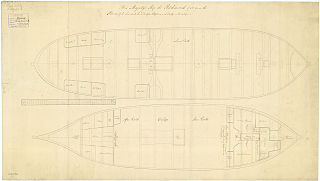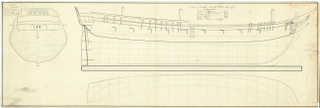Thirteen vessels of the Royal Navy have borne the name HMS Mohawk, after the Mohawk, an indigenous tribe of North America:
Seven vessels of the British Royal Navy have been named HMS Bulldog, after the bulldog, with an eighth announced:
Three Royal Navy ships have borne the name HMS Lutin or Lutine, Lutine being French for "the tease" or "tormentress" or more literally "imp", and Lutine the feminine:

HMS Coventry was a 28-gun sixth-rate frigate of the Royal Navy, launched in 1757 and in active service as a privateer hunter during Seven Years' War, and as part of the British fleet in India during the Anglo-French War. After seventeen years' in British service she was captured by the French in 1783, off Ganjam in the Bay of Bengal. Thereafter she spent two years as part of the French Navy until January 1785 when she was removed from service at the port of Brest. She was broken up in 1786.

HMS Goliath was a 74-gun third-rate ship of the line in the Royal Navy. She was launched on 19 October 1781 at Deptford Dockyard. She was present at the Battle of Cape St Vincent, Battle of the Nile, and Battle of Copenhagen. She was broken up in 1815.
Eight ships of the Royal Navy have borne the name HMS Espiegle

Aréthuse, launched in April 1798, was the name-ship of the eponymous Aréthuse-class corvettes of the French Navy. Excellent captured her in 1799. The Royal Navy took her into service under the name HMS Raven. She was wrecked in 1804.
During the French Revolutionary and Napoleonic Wars Égyptienne, or Egypt, which commemorated Napoleon's Egyptian Campaign, was a popular name for French vessels, including naval vessels and privateers. Between 1799 and 1804, warships of the Royal Navy captured one French frigate and five different French privateers all with the name Egyptienne, and at least one privateer with the name Egypte.

HMS Crescent was a 28-gun Enterprise-class sixth-rate frigate of the Royal Navy. Crescent was launched in 1779. The French captured her in 1781. She was wrecked in 1786.

HMS Richmond was the name ship of the six-vessel, 32-gun Richmond-class fifth-rate frigates of the Royal Navy. She was launched in 1757 and served throughout the American Revolutionary War until the French 74-gun Bourgogne and the frigate Aigrette captured her on 11 September 1781 in the Chesapeake. She then served as Richemont under Lieutenant Mortemart.
Several French ships have borne the name Courageux, Courageaux, or Courageuse:
The French gun-vessel Torride was the cutter Sally, of uncertain origin. The French Navy named her Torride around end-1797 and brought her into Toulon, where they refitted her as a gun-vessel. The Royal Navy captured her in 1798 at Abukir and took her into service as HMS Torride. She served at the siege of Acre in 1799, where the French recaptured her on 25 August for a few hours before the British recaptured her. She served in the Mediterranean and was last listed in 1802.
Numerous French naval vessels have borne the name Résolue, the French for "Resolute", as have several privateers.
Twelve vessels of the French Navy have borne the name Auguste :
The action of 31 May 1796 was a small action during the French Revolutionary Wars in which a Royal Navy squadron under the command of Commodore Horatio Nelson, in the 64-gun third-rate ship of the line HMS Agamemnon, captured a seven-vessel French convoy that was sailing along the coast from Menton to Vado in the Mediterranean. The British succeeded in capturing the entire convoy, with minimal casualties to themselves.

The French gun-vessel Eclair was one of 20 chasse-marées built in 1785 in southern Brittany for use as service craft in harbour construction at Cherbourg. In 1793 Martin or Jacques Fabien converted ten of them into chaloupes-canonnières (gun-vessels). One of these received the name Eclair. Sir Richard Strachan's squadron captured her in 1795 in Cartaret Bay, and the Royal Navy took her into service as HMS Eclair. She then sailed to the West Indies where she was probably out of service by 1801. In 1802 she was hulked under the name HMS Safety. She then served as a prison ship at Jamaica around 1808 to 1810. She may have been sold at Tortola in 1817/18, but in 1841 or so was brought back into service there as a receiving hulk. She was broken up in 1879.
Seven ships of the French Navy have borne the name Sans-Culotte in honour of the Sans-culottes:

HMS Barbuda was commissioned into the Royal Navy in 1780 after having briefly served as an American privateer. Barbuda was one of the two sloops that captured Demerara and Essequibo in 1781, but the French Navy captured her there in 1782 and took her into service as Barboude. The French Navy sold her to private owners in 1786, and she served briefly as a privateer in early 1793 before the French Navy purchased her again and named her Légère. She served them until mid-1796 when the Royal Navy captured her and took her into service as HMS Legere. She was wrecked off the coast of Colombia, without loss of life, in February 1801.
Two vessels named His Majesty's Hired armed cutter Industry briefly served the British Royal Navy during the Napoleonic Wars as hired armed vessels.
Several ships have been named Sesostris for Sesostris:
This page is based on this
Wikipedia article Text is available under the
CC BY-SA 4.0 license; additional terms may apply.
Images, videos and audio are available under their respective licenses.






